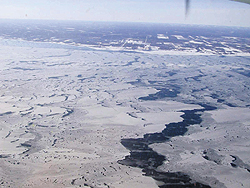1.2 Stages of Development of Sea Ice
- 1.2.1 New Ice
- A general term for recently formed ice which includes frazil ice, grease ice, slush and shuga. These types of ice are composed of ice crystals which are only weakly frozen together (if at all) and have a definite form only while they are afloat.
- Frazil Ice
- Fine spicules or plates of ice suspended in water.
- Grease Ice
- A later stage of freezing than frazil ice where the crystals have coagulated to form a soupy layer on the surface. Grease ice reflects little light, giving the water a matte appearance.
- Slush
- Snow which is saturated and mixed with water on land or ice surfaces or as a viscous floating mass in water after a heavy snowfall.
- Shuga
- An accumulation of spongy white ice lumps having a diameter of a few centimeters across; they are formed from grease ice or slush and sometimes from anchor ice rising to the surface.
 Photo 1.2: Very close pack light nilas and new ice
Photo 1.2: Very close pack light nilas and new ice
- 1.2.2 Nilas
- A thin elastic crust of ice, easily bending on waves and swell and under pressure growing in a pattern of interlocking "fingers" (finger rafting). Nilas has a matte surface and is up to 10cm in thickness and may be subdivided into dark nilas and light nilas.
- Dark Nilas
- Nilas up to 5 cm in thickness and which is very dark in colour.
- Light Nilas
- Nilas which is more than 5 cm in thickness and lighter in colour than dark nilas.
- Ice Rind
- A brittle, shiny crust of ice formed on a quiet surface by direct freezing or from grease ice, usually in water of low salinity. It has a thickness of about 5 cm. Easily broken by wind or swell, commonly breaking into rectangular pieces.
- 1.2.3 Young Ice
- Ice in the transition stage between nilas and first-year ice, 10-30 cm in thickness. May be subdivided into grey ice and grey-white ice.
- Grey Ice
- Young ice 10-15 cm thick, less elastic than nilas and breaks on swell. It usually rafts under pressure.
- Grey-White Ice
- Young ice 15-30 cm thick. Under pressure it is more likely to ridge than to raft.
- 1.2.4 First-year Ice
- Sea ice of not more than one winter's growth, developing from young ice; 30 cm or greater. It may be subdivided into thin first-year ice - sometimes referred to as white ice -, medium first-year ice and thick first-year ice.
 Photo 1.3: Container ship tracking through a large pan of thin first-year ice
Photo 1.3: Container ship tracking through a large pan of thin first-year ice
- Thin First-year Ice/White Ice -First Stage
- 30-50 cm thick.
- Thin First-year Ice/White Ice-Second Stage
- 50-70 cm thick.
- Medium First-year Ice
- 70-120 cm thick.
- Thick First-year Ice
- Greater than 120 cm thick.
- 1.2.5 Old Ice
- Sea ice which has survived at least one summer's melt. Topographic features generally are smoother than first-year ice. It may be subdivided into second-year ice and multi-year ice.
 Photo 1.4: Large pans of old ice showing secondary drainage pattern and puddling
Photo 1.4: Large pans of old ice showing secondary drainage pattern and puddling
- Second-year Ice
- Old ice which has survived only one summer's melt. Thicker than first-year ice, it stands higher out of the water. In contrast to multi-year ice, summer melting produces a regular pattern of numerous small puddles. Bare patches and puddles are usually greenish-blue.
- Multi-year Ice
- Old ice which has survived at least two summer's melt. Hummocks are smoother than on second-year ice and the iceis almost salt-free. Where bare, this ice is usually blue in colour. The melt pattern consists of large interconnecting, irregular puddles and a well-developed drainage system.

